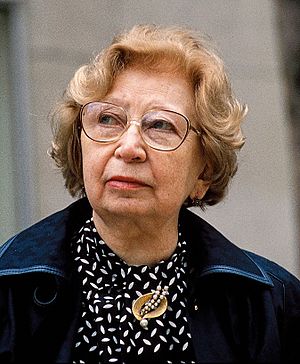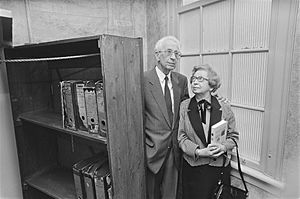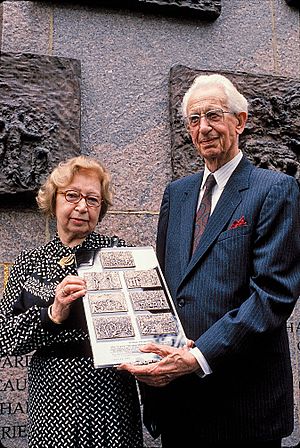Miep Gies facts for kids
Quick facts for kids
Miep Gies
|
|
|---|---|

Miep Gies (1987)
|
|
| Born |
Hermine Santruschitz
15 February 1909 Vienna, Austria-Hungary (Now Austria)
|
| Died | 11 January 2010 (aged 100) Hoorn, Netherlands
|
| Known for | Hiding Dutch Jews, including Anne Frank and her family, from the Nazis |
| Spouse(s) | |
| Children | 1 |
Miep Gies (born Hermine Santrouschitz; 15 February 1909 – 11 January 2010) was a brave Dutch woman who helped hide Anne Frank and her family during World War II. She was born in Austria but moved to the Netherlands when she was 11 years old. Miep Gies worked for Anne Frank's father, Otto Frank, and became a trusted friend of the family.
During the war, the Nazis were persecuting Jewish people. Miep Gies and others helped the Frank family and four other Jewish people hide in a secret annex above Otto Frank's business. Miep brought them food and news for over two years. After the family was arrested, Miep Gies saved Anne Frank's diary. She kept it safe until Otto Frank returned after the war. He was the only one in his family to survive. Miep gave him Anne's diary, which later became a famous book. Miep Gies lived to be 100 years old.
Miep Gies's Early Life
Miep Gies was born in Vienna, Austria, in 1909. After World War I, there was not enough food in Austria. So, in 1920, Miep moved to Leiden, Netherlands, to live with a foster family. They called her "Miep," which became her known name.
In 1922, Miep moved with her foster family to Amsterdam. She was a good student and described herself as quiet but independent. After high school, she worked as an accountant. In 1933, she started working as a secretary for a German spice company called Opekta. This company was run by Otto Frank.
Miep became good friends with the Frank family. Her fiancé, Jan Gies, also became close to them. In 1941, Miep and Jan got married. This was important because Miep was ordered to return to Austria (which was then controlled by Germany). By marrying Jan, she became a Dutch citizen and could stay in the Netherlands. Miep spoke both Dutch and German, which helped the Frank family settle into their new life in the Netherlands.
Helping Families Hide
Miep Gies, her husband Jan, and other co-workers helped hide eight people from the Nazis. These included Otto and Edith Frank, their daughters Margot and Anne, and the van Pels family (Hermann, Auguste, and Peter), and Fritz Pfeffer. They hid in secret rooms above the company's office in Amsterdam.
Miep was very worried about the Jewish people in Amsterdam. She saw trucks taking them to Nazi camps. She knew she had to help. Miep did not tell anyone about the people in hiding, not even her own foster parents.
Every day, Miep would buy food for the hidden families. She was very careful not to look suspicious. She visited different shops and never carried too much at once. Her husband, Jan, also helped by getting illegal ration cards for food. Miep and Jan also hid an anti-Nazi university student in their own apartment.
The Capture
On 4 August 1944, the hiding place was discovered. Miep Gies and her colleagues were confronted by a man with a gun. The families in hiding were arrested, along with two of the helpers.
The next day, Miep went to the German police office. She tried to offer money to free the arrested people, but she was not successful. Miep and the other helpers could have been killed for hiding Jewish people. However, the police officer who questioned her was from Vienna, Miep's hometown. He recognized her accent and let her go. Miep and Jan stayed safe in Amsterdam for the rest of the war.
Before the police emptied the hiding place, Miep and another secretary, Bep Voskuijl, found parts of Anne Frank's diaries. They saved them in a desk drawer. Miep hoped to give them back to Anne. After the war, it was confirmed that Anne Frank had died in a concentration camp. Miep then gave the diaries to Otto Frank, the only survivor from the secret annex. Otto Frank later arranged for the diary to be published in 1947. Miep did not read the diaries before giving them to Otto. She later said that if she had, she might have had to destroy them because they contained the names of all the helpers.
Honors and Awards
Miep Gies received many awards for her bravery. In 1994, she received the Order of Merit of the Federal Republic of Germany. She also received the Wallenberg Medal from the University of Michigan. In 1995, she was given the Yad Vashem Righteous Among the Nations medal. This award honors non-Jewish people who risked their lives to save Jews during the Holocaust.
In 1997, Queen Beatrix of the Netherlands made her a knight in the Order of Orange-Nassau. Even a small planet, 99949 Miepgies, was named after her! Despite all these honors, Miep always said she was not a hero. She believed she only did what any good person would have done.
In 2009, she received the Grand Decoration of Honour for Services to the Republic of Austria.
Death
Miep Gies passed away on 11 January 2010, just one month before her 101st birthday. She died in the city of Hoorn after a fall.
See also
 In Spanish: Miep Gies para niños
In Spanish: Miep Gies para niños




